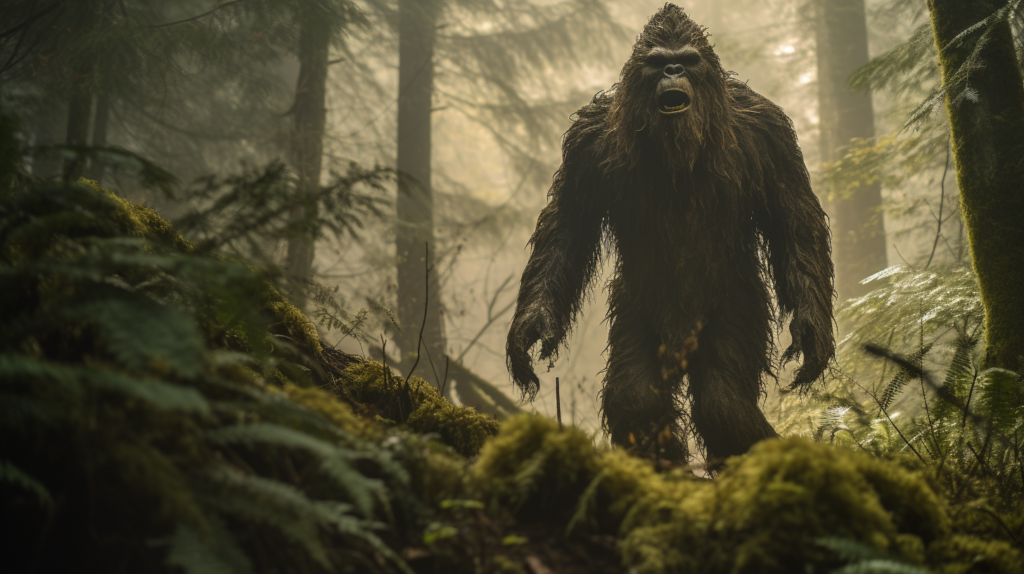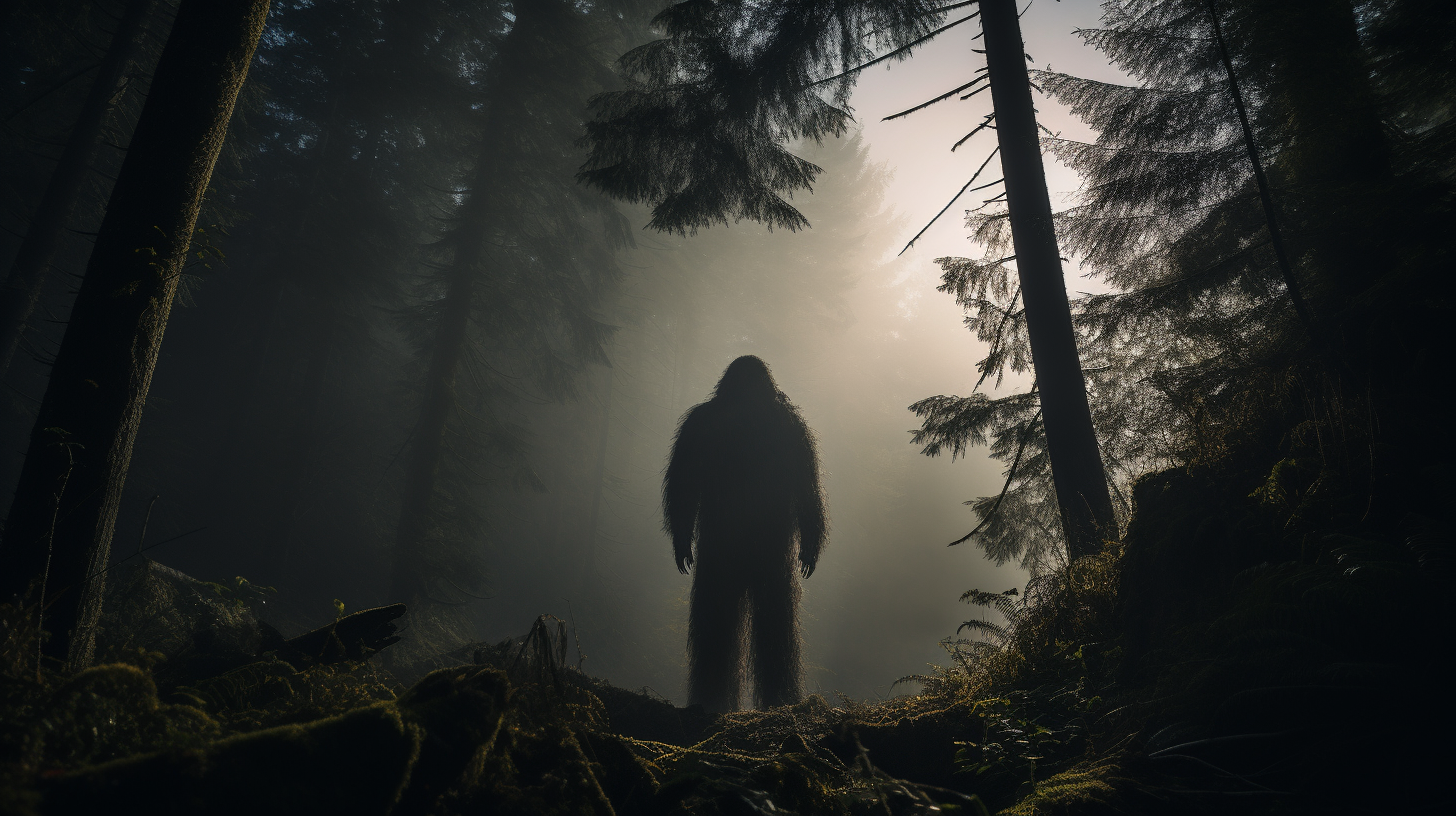The elusive figure of Bigfoot, also known as Sasquatch, stands tall in the wilderness of North American folklore.
This mythical creature, often depicted as a large, hairy bipedal hominid, has become the cornerstone of countless local legends and myths, weaving its way into the cultural fabric of many communities.
Reports of mysterious footprints and shadowy sightings have fueled the imaginations of enthusiasts and skeptics alike, leaving an indelible mark on regional storytelling and identity.
These anecdotal encounters with Bigfoot are not merely isolated tales; they serve as a catalyst for a larger narrative that resonates with the human fascination for the unknown.
The phenomenon of Bigfoot sightings continues to influence local legends, often giving rise to festivals, dedicated museums, and even guide-led tours that promise a glimpse into the world of this legendary woodland giant.
Through this engagement, Bigfoot transcends the boundaries of mere myth and becomes an integral part of a community’s lore, contributing to the area’s sense of mystery and charm.
As the legend of Bigfoot endures through time, it also impacts the way people perceive and interact with the wilderness around them.
The possibility of such a mythical creature’s existence challenges one’s understanding of the natural world and sparks a sense of adventure.
The Bigfoot narrative serves not only as a thrilling campfire story but also underscores a deeper connection between humans and the vast, unexplored expanses of nature.
Through the continual sharing and reshaping of Bigfoot stories, the legend lives on, inspiring curiosity and wonder in the hearts of those who dare to contemplate the mysteries lurking in the forested corners of the continent.
The Roots of Bigfoot Legend in Local History
The Bigfoot legend is anchored in a combination of indigenous lore and modern fascination. Its roots in local history trace back to long before it captured the public’s imagination in the 20th century.
Origins and Evolution of the Bigfoot Legend

The Bigfoot legend has its origins in the folklore of Native American tribes, particularly those in the Pacific Northwest. Here, tales of large, hairy, human-like creatures have existed for centuries, often under different names such as the Yeti in the Himalayas, or the Abominable Snowman across different cultures.
In the mid-20th century, these indigenous stories would converge with contemporary accounts, embedding Bigfoot firmly into local history and beyond.
In 1958, the Bigfoot legend gained widespread attention when the Humboldt Times newspaper published an article about large footprints found in Northern California.
This coverage was instrumental in shaping modern perceptions of Bigfoot and demonstrates the legend’s transformation from indigenous lore to mainstream media narrative.
Notable Early Sightings and Reports
One of the earliest pivotal accounts that solidified the Bigfoot legend was the discovery of oversized footprints surrounding a construction site in Northern California in 1958.
These cast footprints, some measuring up to 24 inches long, sparked local and eventually national interest. They also inspired the name “Bigfoot,” as the Humboldt Times played a crucial part in coining the term.
Additional reports and sightings continued to build the legend, such as the famous Patterson-Gimlin film from 1967, which purported to show a Bigfoot walking through a clearing in the woods.
While the authenticity of many sightings is debated, stories like these have become a significant aspect of history and legends within the communities of the Pacific Northwest and beyond, contributing to the cultural tapestry surrounding the enigmatic creature known as Bigfoot.
Cultural and Societal Impact
The elusive figure of Bigfoot has not only captivated the imaginations of those who claim to have seen it but has also shaped cultural narratives and popular media, permeating various aspects of society from family story-telling to grander media productions.
Influence of Bigfoot on Popular Culture
Bigfoot hunters and enthusiasts have been pivotal in bringing the legend of Bigfoot into popular culture. Their pursuits have inspired a wave of media attention, including books, documentaries, and TV shows.
The Patterson-Gimlin film, which purportedly captures Bigfoot on camera, has become a reference point for many adaptations, fueling fascination and skepticism alike.
‘Harry and the Hendersons’, a family comedy film, is one of the more light-hearted takes on the Bigfoot mythos, portraying the creature as a gentle giant misunderstood by society. These portrayals have ranged from the comical to the terrifying, signifying Bigfoot’s versatile impact on film and television.
- Books: Bigfoot has been the subject of various publications, with works like ‘The Life and Times of a Legend’ detailing its cultural significance.
- Television: From dedicated reality shows to animated guest appearances, Bigfoot’s influence spans across genres and formats.
Bigfoot and Indigenous Narratives
The Bigfoot legend is deeply intertwined with Native American lore. For many tribes, creatures resembling Bigfoot—often known by different names—carry significant cultural and spiritual importance.
The Sasquatch or Bigfoot is known as ‘Sasq’ets’ in the Halq’emeylem language, connecting the mythical being to the land and its original stories. Local legends often speak of Bigfoot in a context that is not just mythological but also serves to convey moral lessons or represent natural elements.
Witnesses from within Native communities can sometimes see Bigfoot as not merely a creature of curiosity but as a part of their ancestral heritage and a living element of their storytelling tradition.
- Tribal Influence: Bigfoot’s characteristics and narratives within indigenous traditions vary, reflecting diverse beliefs and values.
- Cultural Significance: The accounts of Bigfoot serve as a bridge between the natural world and the spiritual beliefs of many Native American families.
Scientific Perspectives and Debates
In the discussion of Bigfoot, scientific perspectives shed light on the evidence and contribute to ongoing debates between mainstream science and the proponents of cryptozoology.
Evidence and Counterarguments in Science
Scientists typically require empirical evidence to substantiate claims, placing the existence of Bigfoot under scrutiny. Evidence for Bigfoot often includes eyewitness accounts and physical traces like footprints.
However, skeptics point out the absence of evidence is not evidence of absence, arguing that conclusive proof, such as DNA evidence or a living specimen, is lacking. The scientific community, valuing replicable results, often disputes the veracity of the evidence provided.
For instance, hair samples attributed to Bigfoot have frequently been shown to belong to known wildlife species. Notably, even prominent figures such as Jane Goodall have expressed openness to the existence of Bigfoot, indicating that curiosity persists within the scientific community about such creatures.
Cryptozoology vs. Mainstream Science
Cryptozoology, the study of creatures whose existence has not been proven, often clashes with mainstream science due to differing standards of proof.
Cryptozoologists argue that the discovery of new animal species supports the potential for undiscovered creatures like Bigfoot.
Mainstream science, however, maintains a skeptical stance towards cryptozoological claims, emphasizing rigorous methodology and verifiable evidence. This skepticism is rooted not in denial but in adherence to scientific methods.
Despite the debate, both fields contribute to the larger narrative of human curiosity and the exploration of the natural world.
Modern Bigfoot: Sightings, Research, and Tourism
Bigfoot continues to capture the imagination through numerous sightings and encounters, as well as sparking interest in research and boosting tourism, especially in regions like Washington and Canada.
Contemporary Bigfoot Sightings and Encounters
Reports of Bigfoot, also known as Sasquatches, are prevalent particularly in North America, with many campers and hunters claiming to have encountered these elusive creatures.
The most famous evidence comes from the 1967 Roger Patterson film, which purportedly captured a Bigfoot on camera in Northern California. While the authenticity of the film remains subject to debate, it has undeniably contributed to a surge in interest.
Organizations such as the Bigfoot Field Researchers Organization (BFRO) actively compile and investigate these sightings. They maintain a comprehensive database, aiming to validate the phenomenon scientifically.
Enthusiasts often refer to this resource for potential expedition locations, highlighting encounters from remote forests in Washington state to the rugged wilderness of Canada.
Impact on Local Economies and Tourism
The fascination with Bigfoot is not just about sightings; it has substantial implications for local economies as well.
Towns near reported sighting hotspots frequently embrace their association with Bigfoot. For instance, the Bigfoot Information Center and Exhibition in Washington provides informational resources and attracts visitors, contributing to the local economy.
- Tourism: Businesses capitalize on the Bigfoot legend through themed tours, merchandise, and festivals.
- Hospitality: Increased number of visitors benefits hotels, restaurants, and other local services.
The lure of possibly encountering a Bigfoot also stimulates outdoor recreational activities. Campers and hikers are drawn to areas notorious for sightings, sometimes in hopes of spotting evidence themselves. This enthusiasm supports a vibrant tourism sector that revolves around the mystery and lore of Bigfoot.
Frequently Asked Questions
These are common inquiries regarding the intersection of Bigfoot sightings with local legends and cultural narratives which often impact communities and their traditions.
What cultural impacts do Bigfoot sightings have on local communities?
In various regions, the presence of Bigfoot is more than just a curious tale; it shapes cultural identity and community cohesion. For example, in northern California, sightings have fostered a sense of mystique and regional pride among residents.
In what ways do legends of Bigfoot evolve after reported encounters?
Legends of Bigfoot often expand following reported sightings, incorporating new descriptions and behaviors attributed to the creature. This can lead to a richer tapestry of folklore that becomes more specific and detailed as stories are passed down and evolve.
How do reported Bigfoot sightings affect tourism and local economies?
In areas known for sightings, Bigfoot has become an economic driver, leading to themed businesses and events that attract visitors keen to explore the mystery firsthand, thus boosting local tourism.
What role do Bigfoot stories play in the oral traditions of an area?
Bigfoot stories are integral to the oral traditions of certain areas, serving as cautionary tales, conversation pieces, and a form of entertainment that reinforces community bonds and shared experiences.
How do personal accounts of Bigfoot sightings contribute to regional folklore?
Personal accounts of Bigfoot sightings add a layer of authenticity and immediacy to regional folklore, often leading to the creation of new narratives that reflect contemporary values and communal aspirations.
What is the relationship between Bigfoot sightings and indigenous myths in the area?
Bigfoot sightings can intersect with indigenous myths, either reinforcing long-standing traditions about similar creatures or introducing new dimensions to the cultural understanding and significance of such entities within a community.

